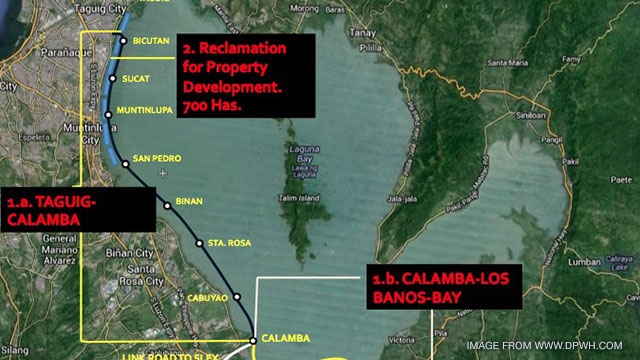SUMMARY
This is AI generated summarization, which may have errors. For context, always refer to the full article.

MANILA, Philippines – In his 5th State of the Nation Address (SONA) on Monday, July 28, President Benigno Aquino III cited the infrastructure projects that would lessen flooding, prevent drought, and map flood-prone villages as part of disaster preparedness efforts.
Except for the mapping project, the projects that the President boasted about pose environmental risks and threaten to displace communities.
Laguna Lakeshore Expressway Dike
The Laguna Lakeshore Expressway Dike is the biggest Public-Private Partnership project undertaken by the Aquino administration. Approved by the National Economic Development Board (NEDA) on June 19, 2014, it costs almost P123 billion ($2.8 billion)*. Bidding for the project will open “before the end of 2014,” the President said.
He said the dike will lessen flooding in surrounding areas and will make Laguna Lake water cleaner.
“Today, when water levels of the Laguna Lake reach 12.5 meters, surrounding communities will be flooded. The solution: a dike with a height of more than 15 meters,” the President said.
It aims to prevent flooding of communities around Laguna Lake by providing a dike that will stop rising water from entering the communities.
Running 47 kilometers from Taguig in Metro Manila to Los Baños in Laguna, with 6 lanes, it aims to relieve traffic in the South Luzon Expressway, Manila South Road, and the National Highway from Calamba to Los Baños.
When first presented to NEDA on May 29, the project was rejected after concerns were raised on its environmental impacts and other technical concerns.
The NEDA Board raised questions over the height of the dike, the construction of water circulation, the separation between the low-lying communities and the new islands that would be created as part of the reclamation, the establishment of pumping stations, among others.
According to the Department of Public Works and Highways (DPWH), construction of the expressway dike will begin in 2015 and will be completed in 2021.
Militant fisherfolk group Pamalakaya (Pambansang Lakas ng Kilusang Mamamalakaya) says construction of the expressway dike might lead to the displacement of thousands of small fisherfolk who live around the lake.
The dike will also likely block fishermen’s boats from reaching their fishing grounds, ultimately affecting their source of livelihood, said Pamalakaya vice-chairman Salvador France.
They believe the project is more to the benefit of investors and developers who will be given a portion of the reclaimed land as payment for the construction of the expressway-dike.
Kaliwa Dam and Angat Dam
The Kaliwa Dam project and repairs of Angat Dam were given the green light last May because, as the President said in his SONA: “According to some studies, there may be a shortage of water in Metro Manila by 2021. We will not wait for a drought: The solutions that experts have studied assiduously, we have already approved.”
The Kaliwa Dam, worth P18.7 billion ($431 million)*, is expected to produce 600 million liters of water a day. Angat Dam supplies around 90% of Metro Manila’s water requirements.
But environmentalists, such as the Save Sierra Madre Network, fear the construction of the Kaliwa Dam will inundate communities that live near Kaliwa River as well as forests around the river. They ask if there is a plan to relocate the affected families.
DREAM-LiDAR flood mapping
In his SONA, Aquino said the DREAM-LiDAR project under Project NOAH is intended to help government “more efficiently pinpoint areas that are prone to flooding.” To “determine which areas immediately suffer from the effects of torrential rain,” he said 19 out of our targeted 20 river systems have already been mapped.
According to the Department of Science and Technology, hazard mapping has been completed for only 18 major river basins. This enabled Project NOAH to complete flood hazard maps for more than 5,060 villages. – Rappler.com
*US$1 = P43.38
Add a comment
How does this make you feel?
There are no comments yet. Add your comment to start the conversation.